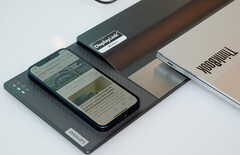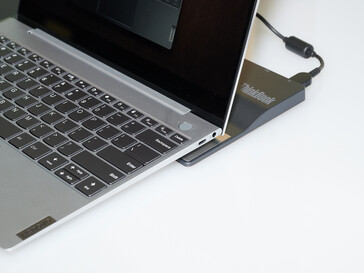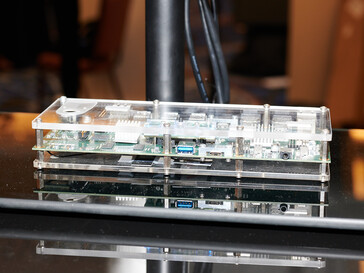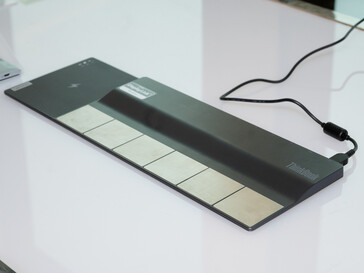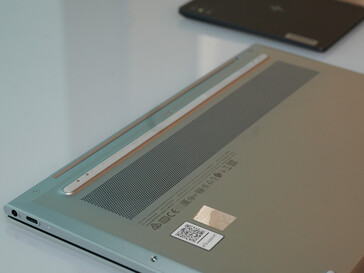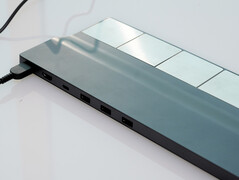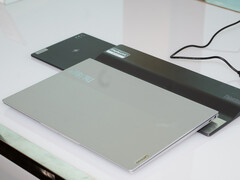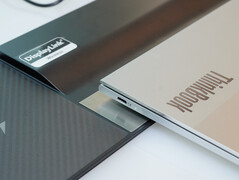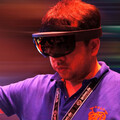With the Thinkbook 13x Gen 2 introduced at CES, Lenovo also introduces a new docking mechanism the manufacturer calls wireless docking. The name is really an oxymoron, since "wireless" docking still needs a physical connection. However, the concept behind it doesn't need it, as long as the battery lasts.
Notebookcheck.com spoke about the technology with Synaptics, the developer of the docking concept, as well as with Lenovo, and we also took a closer look at the system. To understand wireless docking, we have to start somewhere else first.
The basis of this concept is DisplayLink. This technology was purchased by Synaptics a few years ago, a company that laptop users generally know for their trackpads or similar devices. Synaptics then turned DisplayLink, a standard that allows connecting additional displays via USB ports, into wireless DisplayLink, which is the basis of the wireless dock concept. However, this still uses the USB standard, since USB signals are transmitted wirelessly.
To do this, Synaptics uses WLAN technology. Ideally, Synaptics explains in our conversation, the 5-GHz band is used via the WiFi 6 standard, but the 2.4-GHz band can also be used. In ideal conditions, you can then also transfer USB signals as well as 2 x 4K60 for monitors. Synaptics demonstrated this at CES with a video as well as a rather static presentation of the technology, including the usage of a mouse.
At first glance, this worked without a delay, even though there were probably hundreds if not more than a thousand WLAN connections from CES visitors mulling around the Synaptics booth at CES. According to Synaptics, the wireless docking system recognizes the available space in the spectrum and adjusts accordingly.
In this way, Synaptics was able to demonstrate "docking" that worked across a distance of several meters. Synaptics calls this "docking on approach." The users simply walks toward the dock, and the keyboard, mouse, and monitors as well as other equipment are connected automatically.
Particularly when working on productive tasks with text documents, the bandwidth is supposed to be very small. The compression recognizes such content and is supposed to ensure that other artifacts don't interfere with the text in particular. At the same time, the codec understands the situation in the WiFi spectrum and is able to adjust, so that the display of the text documents remains sharp, while being able to transfer video content, for example, at a lower quality.
Lenovo requires the direct contact.
In principle, Lenovo's dock is able do all that as well, even if it is probably slightly more limited on the software side. The USB and display "docking" is only activated when the laptop is placed on the physical dock. This has six large metal contact plates where the laptop can be placed fairly freely. If the position of the laptop is shifted by accident, the connection still remains active for 5 seconds.
In other words, Lenovo's ThinkBook doesn't really need the contact, but this is a design decision. However, the 5 seconds are not final yet, and Lenovo is still working on the technology and the ideal value. The advantage of this solution is that if you lift the laptop off the dock, you can be sure that nothing remains connected anymore.
This is important particularly in the business environment. ThinkBooks are positioned below ThinkPads, which represent the professional laptops for business users. Merely the fact that a dock is offered, shows that Lenovo considers business customers and professional customers here.
The ThinkBook 13x Gen 2 is just the beginning. The dock is also slated for additional laptops, even there are no announcements yet. What is interesting is that there are hardly any mechanical limitations anymore, and the dock fits wider as well as smaller laptops.
In addition, classical docks must be constructed to be very robust. A professional laptop is at times connected to such a dock accompanied by some interesting mechanical noises and also allows for such a relatively careless treatment of the hardware. This distinguishes those docks from USB-C docks, which are still more delicate, aside from Lenovo's double USB docking solution that simply uses USB Type-C in a mechanically more robust dock.
In contrast, nothing much could happen to the wireless dock, since it is just lying there. The metal contact plates are large and accurate placement is completely unnecessary. For administrators, this has the potential of alleviating some problems, since the chance of damage from docking should obviously be much smaller.
The back of the dock holds the important connections that are then wirelessly connected with the data channels of the laptop. However, there are only few connections for a dock. There are a couple of USB-A ports, and USB Type-C including an alternate mode for DisplayPort, as well as an HDMI port and a power connection are also available. Apparently, more isn't necessary in the ThinkBook market.
In addition, the dock also includes a wireless Qi charging area with 10 watts of power. When trying it out briefly, we saw that an iPhone 12 mini could be placed fairly freely. Easily visible control LEDs also indicate whether the dock works correctly or the smartphone is connected, so those who still make a mistake will notice this quickly. However, in contrast to Synaptics, Lenovo hasn't been able to demonstrate this in practice yet.
In the future, it will also be interesting to see how wireless docking works between different systems. According to Synaptics, any wireless DisplayLink laptop can be connected to any corresponding dock.
Macs are left out for now
Those who have used DisplayLink on a Mac in the past should now be able to hope that the concept would also work with Apple's laptops. In principle, this is also the case. Even though Synaptics offers a chip for laptops, it isn't absolutely necessary. Particularly in the area of business customers, some very special and expensive WLAN chips are used. Under Windows, they often come from Intel.
In terms of the hardware technology, the Macs have the option to support wireless docking. However, according to Synaptics, they lack the support of wireless USB in the operating system - or to be exact, of media agnostic USB. And this is also where DisplayLink comes in, since wireless DisplayLink is really DisplayLink via wireless USB.




